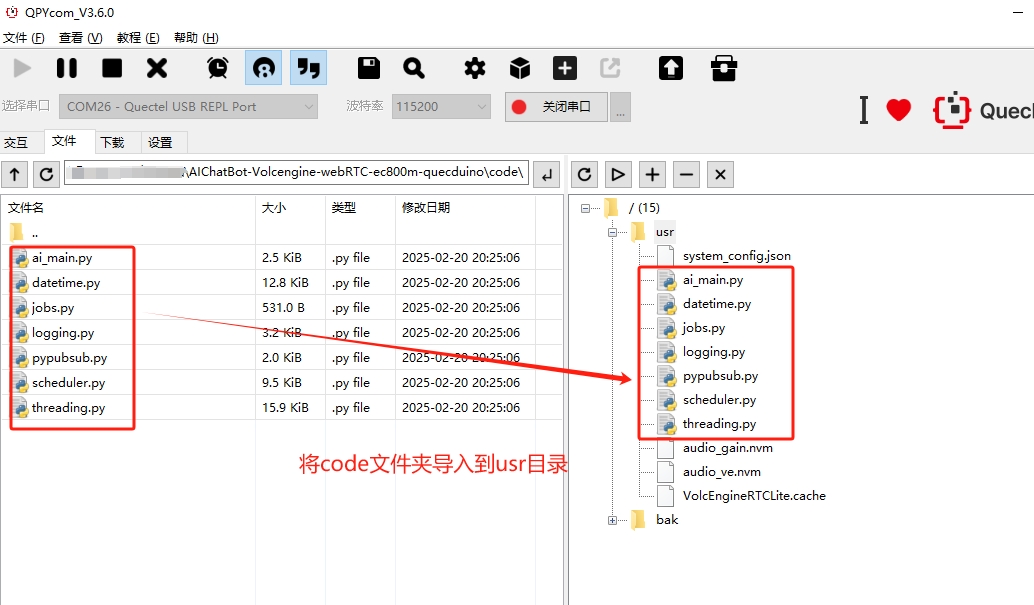Quick Start
Hardware preparation
A Windows computer, recommended for the Win10 system.
a set EC800MCNLE / EC800MCNGB QuecDuino EVB (Including antenna, Type-C data cable, etc).
A Nano SIM card.
A speaker with a power of 2-5W.
Environment construction
Download and install EC800M series module driver: QuecPython_USB_Driver_Win10_ASR.
Download and install VSCode.
Download and unzip QPYCom。
Download Firmware
Download Source code。
💡 Tips
- The volcano dialogue token in the firmware is temporarily being tested and may be cancelled at any time. If you encounter difficulties in joining the room conversation, please contact the remote Fae personnel for support.
- Please follow the business process for commercial applications.
Hardware connection
Connect the hardware according to the following diagram:

- Connect the horn to the pins labeled 'SPK+' and 'SPK -' in the diagram.
- Insert an available Nano SIM card into the position shown in the diagram.
- Connect the antenna to the antenna connector marked with the word 'LTE'.
- Connect the development board and computer using a Type-C data cable.
Equipment development
Power on
After completing the hardware connection work, long press the button labeled 'PWK' on the development board until the network light flashes or a COM port containing the words' Quectel USB 'appears in the port list of the computer device manager, indicating successful boot.

Burn firmware package
Refer to this chapter Burn the corresponding firmware package to the development board.
Script import and execution
- Refer to this chapter Import all files from the 'code' folder in the source code directory into the module file system, as shown in the following figure:


- Refer to this chapter Execute the main program file
ai_main.py. - Refer to this chapter Stop the program from running.
Debugging
Program startup
After executing the 'ai_main. py' script, the program starts running.
Get into the room
Press the KEY S3 key to enter the room. Upon receiving the TIKTOK_STC_SVENT-START event, it indicates successful entry into the room and begins a voice conversation.
Exit the room
Press the KEY S2 key to exit the room, and receiving the TIKTOK_STC_SVENT-STOP event indicates that the exit from the room is successful.
Reference operation log:
import example
>>> example.exec('/usr/ai_main.py')
volume: 11
>>> lte network normal
ai task running
# push down KEY S3 enter
rtc_queue key event 1
start rtc
TIKTOK_RTC_EVENT_START
TIKTOK_RTC_EVENT_TTS_TEXT 你
TIKTOK_RTC_EVENT_TTS_TEXT 你好
TIKTOK_RTC_EVENT_TTS_TEXT 你好有
TIKTOK_RTC_EVENT_TTS_TEXT 你好有什
TIKTOK_RTC_EVENT_TTS_TEXT 你好有什么
TIKTOK_RTC_EVENT_TTS_TEXT 你好有什么可
TIKTOK_RTC_EVENT_TTS_TEXT 你好有什么可以
TIKTOK_RTC_EVENT_TTS_TEXT 你好有什么可以帮
TIKTOK_RTC_EVENT_TTS_TEXT 你好有什么可以帮到
TIKTOK_RTC_EVENT_TTS_TEXT 你好有什么可以帮到你
TIKTOK_RTC_EVENT_TTS_TEXT 你好有什么可以帮到你的
TIKTOK_RTC_EVENT_TTS_TEXT 你好有什么可以帮到你的吗
# push down KEY S2 to exit
rtc_queue key event 2
stop rtc
TIKTOK_RTC_EVENT_STOP
